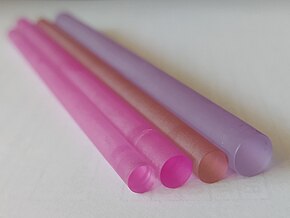A solid-state laser is a laser that uses a gain medium that is a solid, rather than a liquid as in dye lasers or a gas as in gas lasers.[1] Semiconductor-based lasers are also in the solid state, but are generally considered as a separate class from solid-state lasers, called laser diodes.

Solid-state media
editGenerally, the active medium of a solid-state laser consists of a glass or crystalline "host" material, to which is added a "dopant" such as neodymium, chromium, erbium,[2] thulium[3] or ytterbium.[4] Many of the common dopants are rare-earth elements, because the excited states of such ions are not strongly coupled with the thermal vibrations of their crystal lattices (phonons), and their operational thresholds can be reached at relatively low intensities of laser pumping.
There are many hundreds of solid-state media in which laser action has been achieved, but relatively few types are in widespread use. Of these, probably the most common is neodymium-doped yttrium aluminum garnet (Nd:YAG). Neodymium-doped glass (Nd:glass) and ytterbium-doped glasses or ceramics are used at very high power levels (terawatts) and high energies (megajoules), for multiple-beam inertial confinement fusion.
The first material used for lasers was synthetic ruby crystals. Ruby lasers are still used for a few applications, but they are no longer common because of their low power efficiencies. At room temperature, ruby lasers emit only short pulses of light, but at cryogenic temperatures they can be made to emit a continuous train of pulses.[5]
The second solid-state gain medium was uranium-doped calcium fluoride. Peter Sorokin and Mirek Stevenson at IBM's laboratories in Yorktown Heights (US) experimented with this material in the 1960s and achieved lasing at 2.5 μm shortly after Maiman's ruby laser.
Some solid-state lasers can be made tunable by using intracavity etalons, prisms, gratings, or a combination of these.[6] Titanium-doped sapphire is widely used for its broad tuning range, 660 to 1080 nanometers. Alexandrite lasers are tunable from 700 to 820 nm and yield higher-energy pulses than titanium-sapphire lasers because of the gain medium's longer energy storage time and higher damage threshold.
Pumping
editSolid state lasing media are typically optically pumped, using either a flashlamp or arc lamp, or by laser diodes.[1] Diode-pumped solid-state lasers tend to be much more efficient and have become much more common as the cost of high-power semiconductor lasers has decreased.[7]
Mode locking
editMode locking of solid-state lasers and fiber lasers has wide applications as large-energy ultra-short pulses can be obtained.[1] There are two types of saturable absorbers that are widely used as mode lockers: SESAM,[8][9][10] and SWCNT. Graphene has also been used.[11][12][13] These materials use a nonlinear optical behavior called saturable absorption to make a laser create short pulses.
Applications
editThis section needs expansion. You can help by adding to it. (June 2008) |
Solid state lasers are used in research, medical treatment, and military applications, among others.
See also
editReferences
edit- ^ a b c Heller, Jörg (1 March 2022). "A Primer on Solid-State Lasers". www.techbriefs.com. SAE Media Group. Retrieved 7 August 2022.
- ^ Singh, G.; Purnawirman; Bradley, J. D. B.; Li, N.; Magden, E. S.; Moresco, M.; Adam, T. N.; Leake, G.; Coolbaugh, D.; Watts, M. R. (2016). "Resonant pumped erbium-doped waveguide lasers using distributed Bragg reflector cavities". Optics Letters. 41 (6): 1189–1192. Bibcode:2016OptL...41.1189S. doi:10.1364/OL.41.001189. PMID 26977666.
- ^ Su, Z.; Li, N.; Magden, E. S.; Byrd, M.; Purnawirman; Adam, T. N.; Leake, G.; Coolbaugh, D.; Bradley, J. D.; Watts, M. R. (2016). "Ultra-compact and low-threshold thulium microcavity laser monolithically integrated on silicon". Optics Letters. 41 (24): 5708–5711. Bibcode:2016OptL...41.5708S. doi:10.1364/OL.41.005708. PMID 27973495.
- ^ Z. Su, J. D. Bradley, N. Li, E. S. Magden, Purnawirman, D. Coleman, N. Fahrenkopf, C. Baiocco, T. Adam, G. Leake, D. Coolbaugh, D. Vermeulen, and M. R. Watts (2016) "Ultra-Compact CMOS-Compatible Ytterbium Microlaser", Integrated Photonics Research, Silicon and Nanophotonics 2016, IW1A.3.
- ^ "Continuous solid-state laser operation revealed by BTL" (PDF). Astronautics: 74. March 1962.
- ^ N. P. Barnes, Transition metal solid-state lasers, in Tunable Lasers Handbook, F. J. Duarte (Ed.) (Academic, New York, 1995).
- ^ "Diode-Pumped Lasers: Performance, Reliability Enhance Applications". photonics.com.
- ^ H. Zhang et al., "Induced solitons formed by cross polarization coupling in a birefringent cavity fiber laser" Archived 7 July 2011 at the Wayback Machine, Opt. Lett., 33, 2317–2319.(2008).
- ^ D. Y. Tang et al., "Observation of high-order polarization-locked vector solitons in a fiber laser" Archived 20 January 2010 at the Wayback Machine, Physical Review Letters, 101, 153904 (2008).
- ^ L. M. Zhao et al., "Polarization rotation locking of vector solitons in a fiber ring laser" Archived 7 July 2011 at the Wayback Machine, Optics Express, 16,10053–10058 (2008).
- ^ H. Zhang; D. Y. Tang; L. M. Zhao; Q. L. Bao; K. P. Loh (2009). "Large energy mode locking of an erbium-doped fiber laser with atomic layer graphene" (PDF). Optics Express. 17 (20): 17630–5. arXiv:0909.5536. Bibcode:2009OExpr..1717630Z. doi:10.1364/OE.17.017630. PMID 19907547. S2CID 207313024. Archived from the original (PDF) on 17 July 2011.
- ^ Han Zhang; Qiaoliang Bao; Dingyuan Tang; Luming Zhao & Kianping Loh (2009). "Large energy soliton erbium-doped fiber laser with a graphene-polymer composite mode locker" (PDF). Applied Physics Letters. 95 (14): 141103. arXiv:0909.5540. Bibcode:2009ApPhL..95n1103Z. doi:10.1063/1.3244206. S2CID 119284608. Archived from the original (PDF) on 17 July 2011.
- ^ "Graphene: Mode-locked lasers". NPG Asia Materials. 21 December 2009. doi:10.1038/asiamat.2009.52.
- Koechner, Walter (1999). Solid-State Laser Engineering (5th ed.). Springer. ISBN 978-3-540-65064-5.